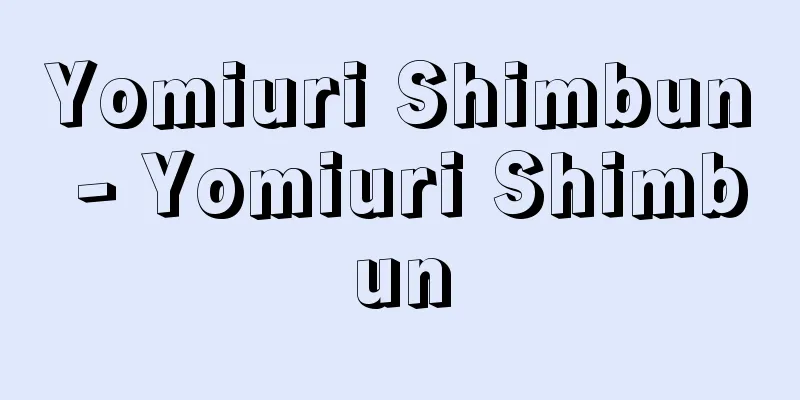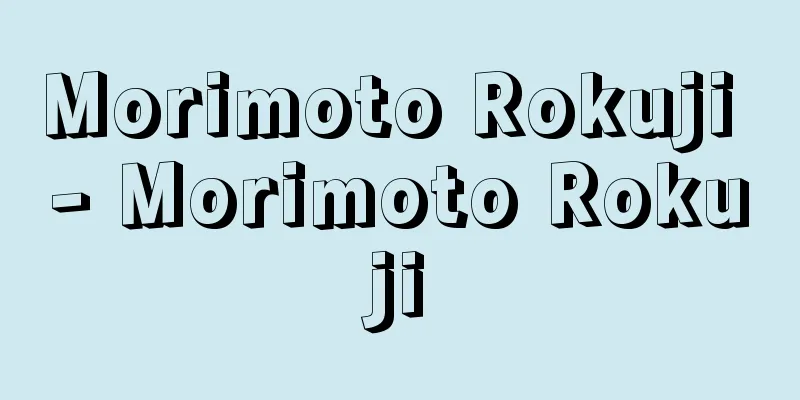Yomiuri Shimbun - Yomiuri Shimbun

|
It is one of Japan's leading national newspapers and boasts the largest circulation in the world. Meiji PeriodIt was first published in Tokyo on November 2, 1874 (Meiji 7) by Koyasu Takashi (1836-1898) and others. At first it was a small newspaper, published every other day with furigana and common conversation, but it quickly gained popularity among ordinary people, achieved the highest circulation in the newspaper industry, and became a daily paper on May 1 of the following year. In January 1890, Motono Morimichi became president, and when Takada Sanae (editor-in-chief) and Tsubouchi Shoyo joined the company, it became more of a literary newspaper, and many writers, including Koda Rohan and Ozaki Koyo (who published most of their major works in the paper, including "Konjiki Yasha"), joined the company and graced its pages. At the end of the Meiji period, naturalist writers were active at the Yomiuri Shimbun through the connections of its employee, Masamune Hakucho. [Akihiko Sunohara] Taisho periodDuring this time, however, the newspaper was left behind in the movement to become a news newspaper, and gradually fell into financial difficulties, so in September 1919 (Taisho 8), the Motono family left the company and Matsuyama Chujiro (former editor-in-chief of the Tokyo Asahi Shimbun) became president. Matsuyama hired editorial staff, improved the communication network, and revamped the paper, which led to a rapid rise in public popularity. Matsuyama's recovery plan was thwarted when the newly completed new office building was damaged in the Great Kanto Earthquake that occurred on September 1, 1923, and the following year, on February 25, 1924, Shoriki Matsutaro, who had been fired from his position as head of the Metropolitan Police Department for his responsibility in the Toranomon Incident, bought the newspaper and it began to grow. When Shoriki took over the management of the paper, he reformed the layout and introduced new innovations such as launching a radio edition on November 15, 1925, and publishing a Sunday evening edition the following year.He also came up with a series of original projects, which were published in the paper and became very popular, including numerous Go and Shogi games including the Honinbo vs. Karigane match, an unprecedented exhibition of Japanese treasures, and the founding of professional baseball. [Akihiko Sunohara] Showa PeriodWhen the Manchurian Incident occurred in September 1931 (Showa 6), the newspaper began publishing an evening edition on November 25th, and began its journey from being a parallel newspaper to being a news-oriented, main-read paper, competing with the Asahi Shimbun and the Mainichi Shimbun. In August 1929, Mutai Mitsuo (1896-1991) joined the company and took over the sales side of things. Thereafter, the duo of Shoriki and Mutai expanded circulation in the Kanto and Tohoku regions, and even before World War II, the newspaper boasted the largest circulation in Tokyo. In August 1942, as part of a wartime newspaper consolidation, the newspaper merged with the Hochi Shimbun and changed its title to Yomiuri Hochi. After World War II, the newspaper weathered two crises under the leadership of new president Baba Tsunego, including two disputes between October 1945 and 1946 (the Yomiuri Shimbun dispute) and the naming and expulsion of President Shoriki as a suspected war criminal. In May 1946, the newspaper regained its title as the Yomiuri Shimbun, and in November 1952, the Osaka Yomiuri Shimbun was launched (unified with the Yomiuri Shimbun title in 1953). After that, with the return of the monopoly system, the newspaper expanded its circulation nationwide. In 1959, it began printing and publishing in Sapporo, and in 1961 it expanded to Takaoka, in 1964 to Kitakyushu, and in March 1975, the Chubu Yomiuri Shimbun was published by a subsidiary company in Nagoya (which merged in 1988 and unified with the Yomiuri Shimbun title), and printing was also carried out in Aomori, expanding the newspaper's distribution area nationwide. In 1977, it became the first Japanese newspaper to enter the US market and began local printing in New York (it ceased publication in October 2003). [Akihiko Sunohara] Heisei PeriodSince the 1990s, the newspaper has been publishing international satellite editions in Southeast Asia (Bangkok), Europe, and Hong Kong. In Japan, in 1997, the newspaper established a new information processing system that links its three headquarters in Tokyo, Osaka, and the West, three branches in Hokkaido, Chubu, and Hokuriku, and more than 20 distributed printing plants. The paper has published many proposals on politics, government, and the future of Japan, and has attracted attention for its long-running serialization calling for a "renaissance in medicine and education." In 1999, the newspaper expanded its operations by acquiring Chuokoron-Shinsha, which was in financial difficulty, and has recently been eager to launch a website on the Internet. Currently, the newspaper has four bureaus in the United States (Washington), Europe (London), Asia (Bangkok), and China (Beijing), as well as 30 branches around the world. The newspaper is also expanding its reporting network by signing special contracts with news agencies such as AP (USA), Reuters (UK), AFP (France), and the Korea Press, as well as major newspapers and magazines around the world. Circulation: 10.01 million copies for the morning edition and 3.55 million copies for the evening edition (2010). [Akihiko Sunohara] "The Yomiuri Shimbun 100-Year History Editorial Committee, ed., The Yomiuri Shimbun 100-Year History (1976, Yomiuri Shimbun)" ▽ " The Yomiuri Shimbun Corporate History Editorial Office, ed., The Yomiuri Shimbun Development History (1987, Yomiuri Shimbun)" ▽ "The Yomiuri Shimbun 120-Year History (1994, Yomiuri Shimbun)" [References] | | | | |The company's headquarters was located in Ginza, Kyobashi Ward (currently Ginza, Chuo Ward, Tokyo). "Famous Places in Japan" (1900, Meiji 33) National Diet Library Yomiuri Shimbun (Meiji period) Source: Shogakukan Encyclopedia Nipponica About Encyclopedia Nipponica Information | Legend |
|
日本の代表的な全国紙の一つで、世界最大の発行部数を誇る。 明治期1874年(明治7)11月2日、子安峻(たかし)(1836―1898)らが東京で創刊。当初は小(こ)新聞として、俗談平話、振り仮名つきの隔日刊紙だったが、たちまち庶民の人気を集め、新聞界第一の発行部数を獲得、翌年5月1日から日刊紙となった。1890年1月本野盛亨(もとのもりみち)が社長となり、高田早苗(さなえ)(主筆)、坪内逍遙(つぼうちしょうよう)が入社すると文芸新聞としての色彩が強くなり、幸田露伴(こうだろはん)、尾崎紅葉(こうよう)(『金色夜叉(こんじきやしゃ)』など主要作のほとんどを紙上で発表)ほか多くの文人が入社、紙面を飾った。明治末期には、社員正宗白鳥(まさむねはくちょう)の人脈から自然主義作家が『読売新聞』を舞台に活躍した。 [春原昭彦] 大正期しかしこの間、報道新聞化への動きに取り残され、しだいに経営は苦境に陥ってきたため、1919年(大正8)9月、本野家の経営を離れ、松山忠二郎(元『東京朝日新聞』編集局長)が社長になった。松山は編集の人材を入社させるとともに通信網の充実を図り、紙面を刷新したため、世間の人気は急速に高まった。しかし松山の挽回(ばんかい)策も、1923年9月1日に起こった関東大震災で、落成したばかりの新社屋が被災したため挫折(ざせつ)、翌1924年2月25日、虎の門事件(とらのもんじけん)の責任で警視庁警務部長を免官になった正力(しょうりき)松太郎が買収してから発展の途をたどることになる。正力は、経営に乗り出すと、紙面を改革するとともに、1925年11月15日いち早くラジオ版を新設、翌年には日曜夕刊を発行するなどの新機軸を打ち出す一方、本因坊・雁金(かりがね)戦をはじめとする数々の囲碁・将棋対局、空前の日本名宝展開催、職業野球の創始など、次々に独創的企画を打ち出し、紙面に掲載、人気を集めた。 [春原昭彦] 昭和期1931年(昭和6)9月満州事変が起こると、11月25日から夕刊を発行、従来の併読紙から報道重視の主読紙として、『朝日新聞』『毎日新聞』に対抗する途を歩み始める。1929年8月には務台光雄(むたいみつお)(1896―1991)が入社、販売面を一手に引き受け、以後、正力・務台のコンビで関東、東北に部数を伸ばし、第二次世界大戦前すでに東京第1位の部数を誇った。1942年8月、戦時新聞統合で『報知新聞』を合併、『読売報知』と改題した。 第二次世界大戦後は、1945年(昭和20)10月から1946年にかけての2次にわたる争議(読売新聞争議)、正力社長の戦犯容疑者指名・追放などの危機を、新社長馬場恒吾(つねご)の下で切り抜けた。1946年5月『読売新聞』に復題し、1952年11月には『大阪読売新聞』を発刊(1953年『読売新聞』に題字統一)、以後、専売制復帰とともに全国に紙数を伸ばした。1959年札幌で印刷発行を開始したのに続き、1961年高岡、1964年北九州に進出、1975年3月には『中部読売新聞』を名古屋の傍系社から発行(1988年合併、『読売新聞』に題字統一)、青森でも印刷と、全国に発行地を広げた。1977年には日本の新聞界で初めてアメリカに進出、ニューヨークで現地印刷を開始した(2003年10月休刊)。 [春原昭彦] 平成期1990年代以降は、国際衛星版を東南アジア(バンコク)、ヨーロッパ、香港(ホンコン)で発行、国内では、1997年(平成9)に東京、大阪、西部の3本社、北海道、中部、北陸の3支社、二十数か所の分散印刷工場を結ぶ新しい情報処理システムを構築した。紙面では、政治、行政や日本の進路などに数々の提言を発表して話題をよんでいるほか、「医療・教育のルネサンス」を唱えた長期連載などが注目されている。1999年には経営難に陥った中央公論社を傘下に収めるなど業務を拡大、最近ではインターネット上でのウェブサイトの開設にも意欲を燃やしている。現在、アメリカ(ワシントン)、欧州(ロンドン)、アジア(バンコク)、中国(北京(ペキン))の4総局、世界30か所に支局を置いているほか、AP(アメリカ)、ロイター(イギリス)、AFP(フランス)、朝鮮通信などの通信社、世界の有力紙誌と特約を結び、取材網の充実を図っている。発行部数朝刊1001万部、夕刊355万部(2010)。 [春原昭彦] 『読売新聞百年史編集委員会編『読売新聞百年史』(1976・読売新聞社)』▽『読売新聞社社史編集室編『読売新聞発展史』(1987・読売新聞社)』▽『読売新聞社編『読売新聞百二十年史』(1994・読売新聞社)』 [参照項目] | | | | |京橋区銀座(現在の東京都中央区銀座)にあった社屋。『日本之名勝』(1900年〈明治33〉)国立国会図書館所蔵"> 読売新聞社(明治時代) 出典 小学館 日本大百科全書(ニッポニカ)日本大百科全書(ニッポニカ)について 情報 | 凡例 |
<<: Yomiuri dispute - Yomiuri dispute
Recommend
Excoecaria cochinchinensis Lour.
A shrub of the Euphorbiaceae family. It grows to a...
Anethole - Anethole (English spelling)
A colorless liquid with a distinctive anise flavo...
Ichikawa Danjuro (10th generation)
...The name Soshian was given to him by Fujitani ...
Eunice tibiana (English spelling)
...The claw feet have comb-like gills that they u...
Accidental truth - Guzentekishinri
...This is because the essence of God, the "...
General Morphology
…also called recapitulation theory. This is the t...
Diffusion (respiration) - Kakusan
…Whether respiratory function is sufficient is ul...
Villa‐Lobos (English spelling) Heitor Villa‐Lobos
1887‐1959 A representative modern Brazilian compos...
Mount Asahi - Asahidake
This mountain range is on the border between Yamag...
Bushbuck - bushbuck (English spelling)
A mammal of the bovidae family in the order Artiod...
Jinling Eight Families - Jinling Eight Families
The term refers to eight Chinese painters who were...
Lesch-Nyhan syndrome
…A healthy person's urine contains about 0.2 ...
gṛhamedha (English spelling) grhamedha
…Household rituals were very important, and by th...
Kankijuin Temple
…Compared to other Empress's territories, thi...
Taiheiki - Taiheiki
A military tale from the Northern and Southern Co...









